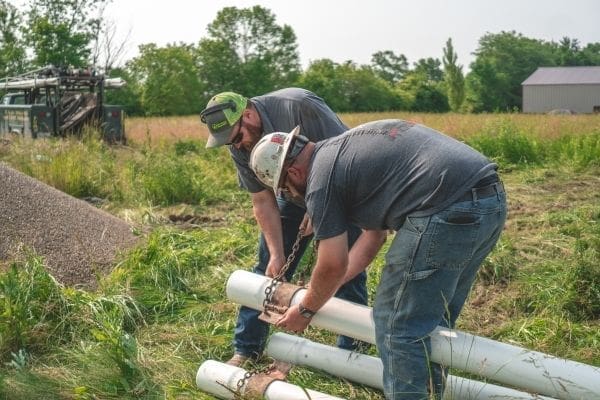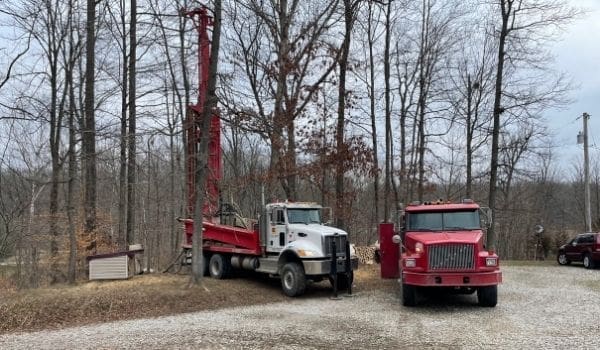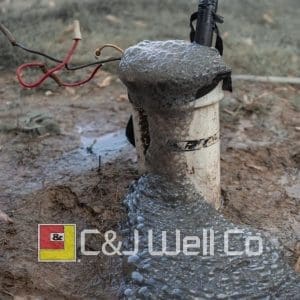When to Have a Replacement Well Drilled
If you have very little water pressure, poor water quality, or low well production, drilling a replacement well might sound like a good idea. In some cases, a replacement well on your property is an appropriate course of action—but not until you’ve first tried these steps.
What Are the Signs of Trouble from My Water Well?
Low Water Pressure
 Regardless of the cause, low water pressure is not something you just have to put up with. Water pressure is the term used to describe the force behind the water that pushes it through the home plumbing system. If the house uses public water, water pressure is controlled by the municipal water system, but for homes with a private well, water pressure is controlled by settings on the well pump. It is measured by pounds per square inch (psi) and should fall somewhere between 40 psi and 60 psi. If the water doesn’t flow from the faucet or showerhead as forcefully as you’d like it to, it could be due to a drop in pressure. A drop in water pressure can sometimes happen when there’s an additional draw in water, such as after building a home addition that includes an additional kitchen or bathroom or installing a new irrigation system.
Regardless of the cause, low water pressure is not something you just have to put up with. Water pressure is the term used to describe the force behind the water that pushes it through the home plumbing system. If the house uses public water, water pressure is controlled by the municipal water system, but for homes with a private well, water pressure is controlled by settings on the well pump. It is measured by pounds per square inch (psi) and should fall somewhere between 40 psi and 60 psi. If the water doesn’t flow from the faucet or showerhead as forcefully as you’d like it to, it could be due to a drop in pressure. A drop in water pressure can sometimes happen when there’s an additional draw in water, such as after building a home addition that includes an additional kitchen or bathroom or installing a new irrigation system.
Drought and periods of heavy water usage could be the cause. While it may seem just annoying to take longer showers or do dishes, it could portend larger issues like low tank pressure, restrictions in your water lines, or even leaks. Something else to consider is you may have the wrong size well pump, or it is set too high in your water well casing. Also, it could be that it is too old and unable to keep up like it used to.
Low Pressure or Low Flow?
Sometimes what seems like low water pressure is actually low water volume, where less water is making it through the pipes than had been flowing previously. Do you have problems with sediment, hard water, or iron in your water? The cause could be clogged pipes or a clogged well casing from a buildup of sediment and minerals. It could also be an improperly placed well pump.
Muddy Water, Cloudy Water, or Water with Sediment
If you have discolored water, or water with sand or sediment coming through your faucet, this is a sign of larger issues with your water well. This could be a result of tannins, iron, or manganese in your water.
Water That Smells or Tastes Weird
If your water is having a weird smell or taste, don’t just get used to it, check into it. Bad taste and odors usually indicate issues with your water quality. Sediment, minerals, metals, or even gases could be finding their way into your water system. While some of these problems are innocuous, others can be dangerous for your family.
Biological Testing Comes Back Positive
As a homeowner with a private water well you are ultimately responsible for the quality of your water. Part of this obligation is regular testing for bacteria and other pathogens. If your test comes back positive for bacteria, you will want to take steps to mitigate it ASAP.
 What should you do first before drilling a replacement well?
What should you do first before drilling a replacement well?
If you are having any of the aforementioned issues, it might be tempting to abandon your well and start over. Just pump the brakes and try some of these steps first.
First, have a professional assess existing well for quality and viability.
C&J offers a six-point inspection that evaluates the water flow in your home, analyzes the health of wiring and piping, checks the pressure of your tank, tests amps of your pump, and even samples your water for dangerous bacteria. It is important to make sure the well components are functioning properly before you consider drilling a replacement well.
Another important step is a well cleanout.
We recommend a well cleaning every 10 years. What we do is remove your submersible pump out of the well, lower a high out-put air line into the well and air lift your years of built-up sediment and gunk out of the top of the well. This process can redevelop your well screen and casing, keep your pump from getting stuck during regular maintenance, and improve water quality, flow, and pressure.
Lowering your well pump is another option to consider.
If your water output has been reduced, it may be a sign that the static level of your well has dropped and your well pump is now too high. There are various reasons why your water level may have dropped—drought, local population increase, groundwater shortage, etc. Whatever the reason, you will want to be sure you have the correct size pump set at the proper level inside your well.
 An additional measure to consider is installing a flow restrictor/regulator.
An additional measure to consider is installing a flow restrictor/regulator.
Basically, a flow restrictor regulates the water flow from your pump to match the production of your well. For example, if your shallow well produces 3 GPM (gallons per minute), but your well pump is rated for 10 or 15 GPM, the pump will attempt higher production and eventually burn out. In this scenario, you need a 3 GPM flow restrictor to keep your pump healthy. C&J can help you determine the right equipment to get the most out of your well.
Furthermore, you may need a new well pump.
An old, worn-out pump isn’t doing your home any favors. An inefficient or inadequately sized pump will raise your electric bill, and eventually cost you more time and money than simply replacing it. Also, if it’s determined that your well pump needs to be lowered inside your existing well, your current pump might not be able to produce at the new depth and you will need to upgrade.
What Are Some Reasons You Would Drill a Replacement Well?
 If you have tried the above measures and still find yourself dealing with low pressure or water shortages, it may be time to consider drilling a replacement well.
If you have tried the above measures and still find yourself dealing with low pressure or water shortages, it may be time to consider drilling a replacement well.
Dry Well
As mentioned in our previous article, your well can in fact go dry. A dry well can be caused by drought, groundwater shortage, or even an increase in population in your area.
In rare cases, a well may need to be drilled deeper to reach additional groundwater. At C&J, we use only the highest quality materials and are selective when choosing an aquifer. The result—your own private water system, implemented by the most trusted Indianapolis well drilling company.
Stuck Well Pump
Well pumps get stuck when the iron in the water oxidizes, forming rust.
Over the years, this rust builds up in your well casing and doesn’t allow enough room for your pump to be removed and serviced. Also, older wells are often smaller in diameter and use steel casing, making it harder to raise your well pump out of the well. Although C&J has all the equipment and procedures to pull your pump out and complete the service, this extra process can be expensive and time-consuming. C&J has several options to remove a stuck pump—such as acid treatment—but sometimes the buildup is too heavy and the well must be abandoned and a replacement well must be drilled.
Collapsed or Damaged Casing
As mentioned above, older wells often have steel casing and when they start corroding and deteriorating they will begin pumping a substance that looks like coffee grounds and sometimes actual flakes of casing. If you see signs of a damaged casing, it’s probably time to get a replacement well drilled. C&J uses non-corroding stainless steel well screens and a 5” PVC well casing. These premium materials combined with a larger-sized borehole and casing ensure that your well can be serviced or repaired for decades to come.

If you are experiencing any of these issues, or have any other questions about the viability of your well or the quality of your water, don’t hesitate to contact C&J and get it checked out.










